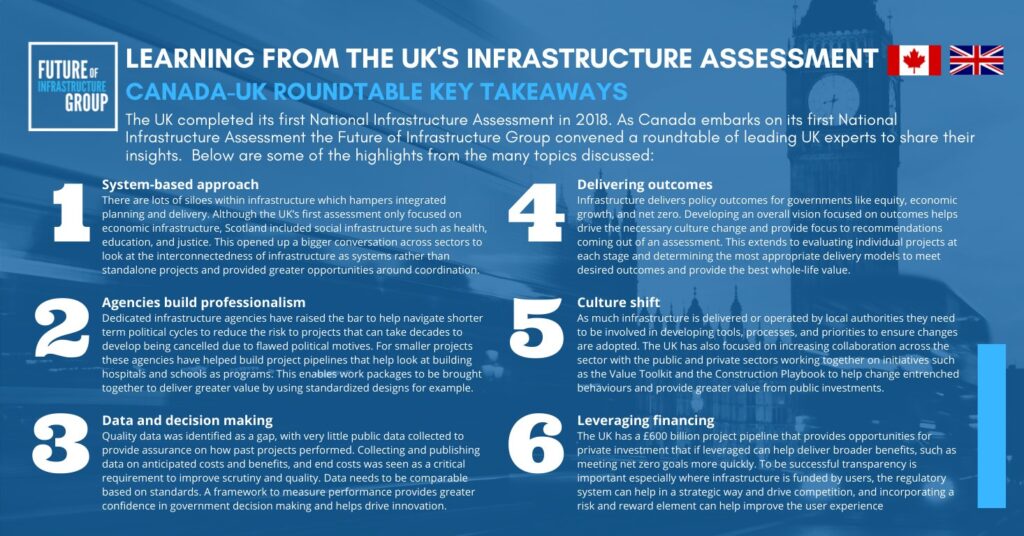Learning from the UK’s National Infrastructure Assessment
Published March 10, 2021
The first National Infrastructure Assessment was published by the National Infrastructure Commission in 2018. Work on the second assessment is already underway and is due to be published in 2023. As well as looking at specific areas such as digital infrastructure, renewable energy, transportation, cities, and water, it also examined how best to choose and design, and fund and finance infrastructure.
The Assessment was used as a basis to develop the UK’s first National Infrastructure Strategy. This roundtable was held in June 2021 and drew lessons from the UK’s experience to ensure investments in infrastructure deliver better value and better outcomes.
Takeaways
- Systems-based approach: There are lots of siloes within infrastructure which hampers integrated planning and delivery. Although the UK’s first assessment only focused on economic infrastructure, Scotland included social infrastructure such as health, education, and justice. This opened a bigger conversation across sectors to look at the interconnectedness of infrastructure as systems rather than standalone projects and provided greater opportunities around coordination.
- Agencies build professionalism: Dedicated infrastructure agencies have raised the bar to help navigate shorter term political cycles to reduce the risk to projects that can take decades to develop being cancelled due to flawed political motives. For smaller projects, these agencies have helped build project pipelines that help look at building hospitals and schools as programs. This enables work packages to be brought together to deliver greater value by using standardized designs for example.
- Data and decision making: Quality data was identified as a gap, with very little public data collected to provide assurance on how past projects performed. Collecting and publishing data on anticipated costs and benefits, and end costs was seen as a critical requirement to improve scrutiny and quality. Data needs to be comparable based on standards. A framework to measure performance provides greater confidence in government decision making and helps drive innovation.
- Delivering outcomes: Infrastructure delivers policy outcomes for governments like equity, economic growth, and net zero. Developing an overall vision focused on outcomes helps drive the necessary culture change and provides focus to recommendations coming out of an assessment. This extends to evaluating individual projects at each stage and determining the most appropriate delivery models to meet desired outcomes and provide the best whole-life value.
- Culture shift: As much infrastructure is delivered or operated by local authorities they need to be involved in developing tools, processes, and priorities to ensure changes are adopted. The UK has also focused on increasing collaboration across the sector with the public and private sectors working together on initiatives such as the Value Toolkit and the Construction Playbook to help change entrenched behaviours and provide greater value from public investments.
- Leveraging financing: The UK has a 600 billion project pipeline that provides opportunities for private investment that if leveraged, can help deliver broader benefits, such as meeting net zero goals more quickly. To be successful, transparency is important especially where infrastructure is funded by users, the regulatory system can help in a strategic way and drive competition and incorporating a risk and reward element can help improve the user experience.

